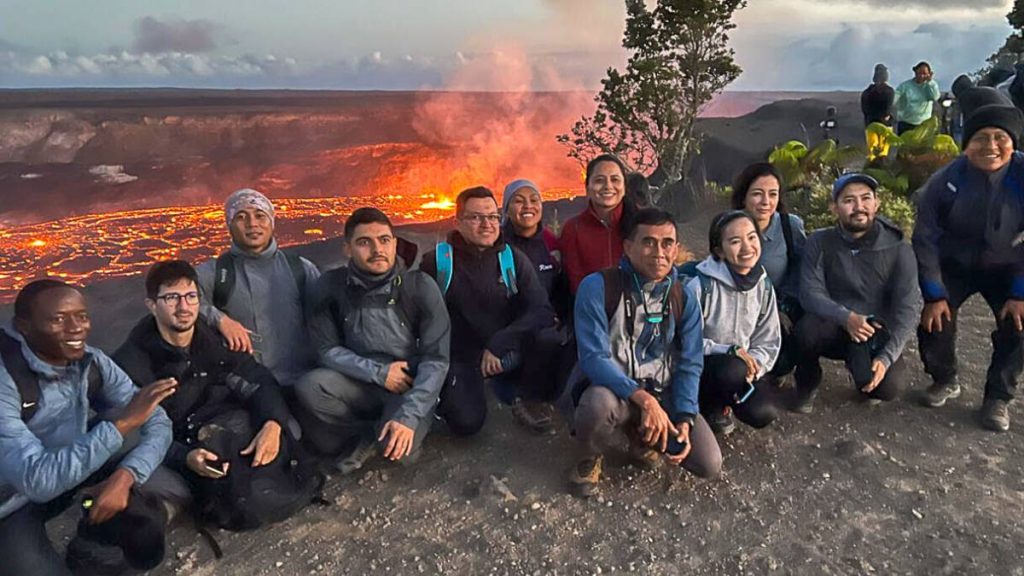Volcano Watch: International scientists resume training in Hawaiʻi

The Center for the Study of Active Volcanoes is holding its annual summer International Training Course in volcano hazards monitoring at Hawaiʻi Volcanoes National Park on the Big Island.
This is the 30th course since its inception in 1990 after first since a three-year hiatus due to the COVID pandemic.
The training course is a product of the partnership between the University of Hawai‘i at Hilo, the University of Hawai‘i at Mānoa, the USGS Hawaiian Volcano Observatory and the USGS Volcano Disaster Assistance Program.
Participants are scientists and technicians working at volcano observatories in developing countries with active volcanoes that threaten populated areas. This year, the 12 participants have traveled to Hawaiʻi from the Philippines, Indonesia, Peru, Chile, the Democratic Republic of Congo, Colombia, Costa Rica and El Salvador.
“After three years of waiting, I’m finally here, directly from Coyhaique from Chilean Patagonia, happy to learn from the instructors and my colleagues,” said Andrea Aguillar, a geophysicist from Chile. “Everything I learn here will be useful for what we do as a country and without a doubt this experience will be the most enriching that I will have in my training as a professional. And, it will be worth being away from my son for so many weeks.”
The eight-week course begins on the Island of Hawai’i, where participants learn techniques used by the Hawaiian Volcano Observatory to monitor shield volcanoes and the hazards associated with Hawaiian-style eruptions.
Juan José Idárraga, a geologist in Colombia, said the international course is the best experience that every volcanologist wants to have.
“I’ve been waiting for the course for some years and it is absolutely worth it,” he said. “We have seen and learned amazing things just in a week. This course gives us the opportunity to learn from the best scientists and in the best natural laboratory: Hawaiian Volcanoes.”
The training course provides an invaluable natural laboratory for studying volcanic eruptions due to the frequent activity on Kīlauea.
“It was definitely worth the wait to finally see the famous Hawaiian Volcanoes we only see in textbooks, plus a warm welcome by Pele,” said Dave Rivera, a research specialist from the Philippines.
The timing for the course was perfect because three days into the program, a spectacular eruption within Halemaʻumaʻu crater began. The participants were able to examine the eruption safely from Uēkahuna bluff, where they viewed the distant lava lake and fountains within Hawai‘i Volcanoes National Park during the first day of the eruption. The group had been anticipating the eruption after observing increased seismic activity on Kīlauea.
Most participants work on volcanoes that can generally erupt more explosively than volcanoes in Hawaiʻi. So, after six weeks of hands-on field and lab work in Hawaiʻi, the group travels to the USGS Cascades Volcano Observatory to spend two weeks working with the Volcano Disaster Assistance Program.
There they will conduct field work to observe geologic hazards such as fast-moving lahars (mud/debris flows) and pyroclastic flows associated with more explosive volcanoes such as Mount St. Helens.
Wahyu Kusuma, a volcano observer from Indonesia, said in addition to learning from highly dedicated course instructors, the participants also learn from one another and build invaluable connections with other scientists.
Many challenges exist in volcano hazard monitoring, because no two volcanoes or eruptions are identical. The participants return home with new modern monitoring techniques and a network of scientific experts and contacts at partner organizations to communicate and share ideas about eruption forecasting and hazard mitigation.
You can read more about the CSAV International course here: https://hilo.hawaii.edu/csav/international/.
Editor’s Note: Volcano Watch is a weekly article and activity update written by scientists and affiliates with the U.S. Geological Survey Hawaiian Volcano Observatory. This week’s article was written by Center for the Study of Active Volcanoes staff Darcy Bevens and Meghann Decker.





